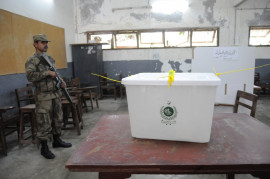
The controversy surrounding talk of electoral fraud during the general elections last year is underwritten by the issue of ‘magnetic ink’. The ink, to be used for thumb impressions of every voter, was to be supplied by the Pakistan Council of Scientific and Industrial Research (PCSIR), a public sector entity responsible for the preparation and provision of the ink, as well as its quality.
The National Database and Registration Authority’s (NADRA) system was reportedly unable to detect the identity of thousands of voters as either substandard ink was used or the thumb impression was not properly marked. It is also said that in many cases, instead of magnetic ink, presiding officers used common ink provided to them to stamp the ballots.

PCSIR, whose office is located right next to the Election Commission of Pakistan (ECP) head office building, was awarded a contract to provide the magnetic ink and a committee comprising bureaucrats from ECP reportedly supervised the process to ensure the ink met specifications.
The ECP has not initiated an inquiry against these officials or discussed the role played by PCSIR, or taken any action against the presiding officers in the constituencies under question. Additionally, there has been no word on the outcome of an inquiry announced by Science and Technology Minister Zahid Hamid, even though PCSIR falls under his jurisdiction.
The ‘ink issue’
Used for the first time in Pakistan on May 11, 2013, the ink was procured at a price much higher than that of common ink, readily available in the market. ECP claimed the magnetic ink would enable verification of each ballot cast, as thumb impressions would be matched against NADRA’s database. The magnetic ink contains iron particles which are attracted to skin ridges in the thumb, thereby increasing the readability of impressions.
NADRA officials say there are around 130 to 150 unique ridges in the thumb of every person. If even 15 unique characters of a thumb are readable, it is enough to enable identification. NADRA officials said regular ink could be used during the polling process, but the thumb impression would have to be marked clearly, with minimal smudging.
Each ink pad with magnetic ink cost the national exchequer Rs200, whereas stamp pads with common ink are available at a cost four times lower than this. Around 70,000 polling stations were setup during the general elections, most of them having more than one polling booth.
Each of these booths was reportedly provided with the magnetic ink, with clear directions to presiding officers to make sure that they get thumb impression of every voter using magnetic ink on the stamp pad.
In the post-election phase, rigging complaints were filed to the 14 tribunals set up across the country with a mandate to decide a case within 120 days of the receipt of the complaint. The tribunals forwarded complaints from three dozen constituencies to NADRA, asking the institution to verify the identity of voters from these areas. NADRA declared over 70% of the votes unverifiable.
Published in The Express Tribune, July 7th, 2014.
COMMENTS (2)
Comments are moderated and generally will be posted if they are on-topic and not abusive.
For more information, please see our Comments FAQ









































If 70% votes confirmed by NADRA as unverifiable, then is it fair to call the election as fair ?
Ah so its not fraud as some parties are claiming it to be but simply bad finger unverifiable prints due to common inks used instead of special ink.